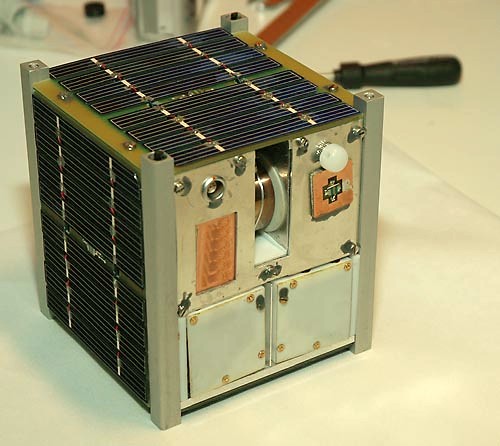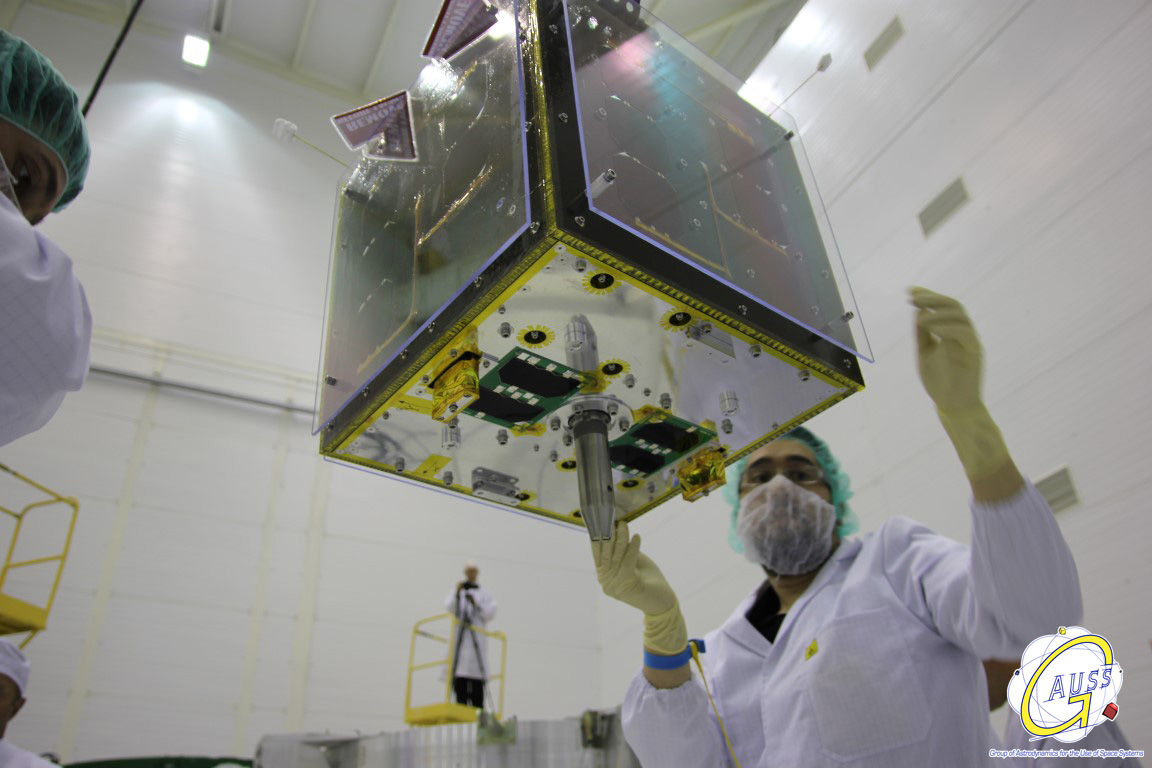|
PRESat
PharmaSat Risk Evaluation Satellite (or PRESat) nanosatellite, for NASA, was about the size of a loaf of bread, weighed about and was constructed in just six months. Spacecraft PRESat, 3U CubeSat, contains a micro-laboratory with a controlled environment packed with sensors and optical systems that can detect the growth, density and health of yeast cells. PRESat was to demonstrate its ability to create a stable, space science laboratory using innovative environment control techniques, and to monitor the levels of pressure, temperature and acceleration. Launch The satellite was lost in the failure of the third Falcon 1 launch, on 3 August 2008, at 03:34 UTC. Mission Although NASA was not able to test this payload in space, NASA mission managers and payload engineers achieved success in this low-cost mission by rapidly pulling together expertise from across the agency to develop, build and ground-test a fundamental space biology micro-laboratory. The communications team ... [...More Info...] [...Related Items...] OR: [Wikipedia] [Google] [Baidu] |
Falcon 1
Falcon 1 was a two-stage small-lift launch vehicle that was operated from 2006 to 2009 by SpaceX, an American aerospace manufacturer. On September 28, 2008, Falcon 1 became the first privately developed fully liquid-fueled launch vehicle to successfully reach orbit. The Falcon 1 used LOX/RP-1 for both stages, the first stage powered by a single pump-fed Merlin engine, and the second stage powered by SpaceX's pressure-fed Kestrel vacuum engine. The vehicle was launched a total of five times. After three failed launch attempts, Falcon 1 achieved orbit on its fourth attempt in September 2008 with a mass simulator as a payload. On July 14, 2009, Falcon 1 made its second successful flight, delivering the Malaysian RazakSAT satellite to orbit on SpaceX's first commercial launch (fifth and final launch overall). While SpaceX had announced an enhanced variant, the Falcon 1e, following this flight, the Falcon 1 was retired in favor of the Falcon 9 v1.0, the first version of ... [...More Info...] [...Related Items...] OR: [Wikipedia] [Google] [Baidu] |
Technology Demonstration
A technology demonstration (or tech demo), also known as demonstrator model, is a prototype, rough example or otherwise incomplete version of a conceivable product or future system, put together as proof of concept with the primary purpose of showcasing the possible applications, feasibility, performance and method of an idea for a new technology. They can be used as demonstrations to the investors, partners, journalists or even to potential customers in order to convince them of the viability of the chosen approach, or to test them on ordinary users. Computers and gaming Technology demonstrations are often used in the computer industry, emerging as an important tool in response to short development cycles in software and hardware development. * Computer game developers use tech demos to rouse and maintain interest to titles still in development (because game engines are usually ready before the art is finished) and to ensure functionality by early testing. Short segments using fi ... [...More Info...] [...Related Items...] OR: [Wikipedia] [Google] [Baidu] |
Small Satellite
A small satellite, miniaturized satellite, or smallsat is a satellite of low mass and size, usually under . While all such satellites can be referred to as "small", different classifications are used to categorize them based on mass. Satellites can be built small to reduce the large economic cost of launch vehicles and the costs associated with construction. Miniature satellites, especially in large numbers, may be more useful than fewer, larger ones for some purposes – for example, gathering of scientific data and radio relay. Technical challenges in the construction of small satellites may include the lack of sufficient power storage or of room for a propulsion system. Rationales One rationale for miniaturizing satellites is to reduce the cost; heavier satellites require larger rockets with greater thrust that also have greater cost to finance. In contrast, smaller and lighter satellites require smaller and cheaper launch vehicles and can sometimes be launched in mult ... [...More Info...] [...Related Items...] OR: [Wikipedia] [Google] [Baidu] |
CubeSats
A CubeSat is a class of small satellite with a form factor of cubes. CubeSats have a mass of no more than per unit,, url=https://static1.squarespace.com/static/5418c831e4b0fa4ecac1bacd/t/5f24997b6deea10cc52bb016/1596234122437/CDS+REV14+2020-07-31+DRAFT.pdf , title=Cubesat Design Specification , publisher=California Polytechnic State University, San Luis Obispo, Cal Poly SLO , year=2020 , location=San Luis Obispo , pages=12 and often use commercial off-the-shelf (COTS) components for their electronics and structure. CubeSats are deployed into orbit from the International Space Station, or launched as secondary payloads on a launch vehicle. , more than 2,300 CubeSats have been launched. In 1999, California Polytechnic State University (Cal Poly) professor Jordi Puig-Suari and Bob Twiggs, a professor at Stanford University Space Systems Development Laboratory, developed the CubeSat specifications to promote and develop the skills necessary for the design, manufacture, and testing of ... [...More Info...] [...Related Items...] OR: [Wikipedia] [Google] [Baidu] |
Spacecraft Launched In 2008
A spacecraft is a vehicle that is designed to fly and operate in outer space. Spacecraft are used for a variety of purposes, including communications, Earth observation, meteorology, navigation, space colonization, planetary exploration, and transportation of humans and cargo. All spacecraft except single-stage-to-orbit vehicles cannot get into space on their own, and require a launch vehicle (carrier rocket). On a sub-orbital spaceflight, a space vehicle enters space and then returns to the surface without having gained sufficient energy or velocity to make a full Earth orbit. For orbital spaceflights, spacecraft enter closed orbits around the Earth or around other celestial bodies. Spacecraft used for human spaceflight carry people on board as crew or passengers from start or on orbit (space stations) only, whereas those used for robotic space missions operate either autonomously or telerobotically. Robotic spacecraft used to support scientific research are space pro ... [...More Info...] [...Related Items...] OR: [Wikipedia] [Google] [Baidu] |
List Of CubeSats
The following is a list of CubeSats, nanosatellites used primarily by universities for research missions, typically in low Earth orbits. Some CubeSats became Timeline of first satellites by country, their country's first national satellite. The extensive Nanosatellite and CubeSat Database lists nearly 4,000 CubeSats and NanoSats have been launched since 1998. The organization forecasts that 2080 nanosats will launch within the next 6 years. Research and development * SBUDNIC was launched to test Arduino Nano and other commercial off-the-shelf technology in space, using a simple, open-source design. * An ambitious project is the QB50, an international network of 50 CubeSats for multi-point by different universities and other teams, ''in-situ'' measurements in the lower thermosphere (90–350 km) and re-entry research. QB50 is an initiative of the von Karman Institute and is funded by the European Union. Double-unit ("2-U") CubeSats (10x10x20 cm) are foreseen, with one unit (t ... [...More Info...] [...Related Items...] OR: [Wikipedia] [Google] [Baidu] |
El Salvador
El Salvador, officially the Republic of El Salvador, is a country in Central America. It is bordered on the northeast by Honduras, on the northwest by Guatemala, and on the south by the Pacific Ocean. El Salvador's capital and largest city is San Salvador. The country's population in 2024 was estimated to be 6 million according to a government census. Among the Mesoamerican nations that historically controlled the region are the Maya peoples, Maya, and then the Cuzcatlan, Cuzcatlecs. Archaeological monuments also suggest an early Olmec presence around the first millennium BC. In the beginning of the 16th century, the Spanish conquest of El Salvador, Spanish Empire conquered the Central American territory, incorporating it into the Viceroyalty of New Spain ruled from Mexico City. However, the Viceroyalty of New Spain had little to no influence in the daily affairs of the isthmus, which was colonized in 1524. In 1609, the area was declared the Captaincy General of Guatemala by the ... [...More Info...] [...Related Items...] OR: [Wikipedia] [Google] [Baidu] |
Central American University (San Salvador)
José Simeón Cañas Central American University (), also known as UCA El Salvador, is a private Catholic university with nonprofit purposes in Antiguo Cuscatlán, El Salvador. It is operated by the Society of Jesus. UCA was founded on September 15, 1965, at the request of a group of Catholic families who appealed to the Salvadoran government and the Society of Jesus in order to create a university as an alternative to the University of El Salvador, becoming the first private institution of higher education in the country. The Jesuits also ran Central American University in Nicaragua (UCA Managua), opened in 1960. History UCA has since evolved to be one of the best institutions of higher learning in Central America (Guatemala, El Salvador, Honduras, Nicaragua, Costa Rica and Panama). This is the case, despite the university's focus on playing a decisive role in the transformation of the unjust Salvadoran society. Such a focus within the Salvadoran context has driven the univer ... [...More Info...] [...Related Items...] OR: [Wikipedia] [Google] [Baidu] |
Marshall Islands
The Marshall Islands, officially the Republic of the Marshall Islands, is an island country west of the International Date Line and north of the equator in the Micronesia region of the Northwestern Pacific Ocean. The territory consists of 29 coral atolls and five main islands as well as 1,220 other very small ones, divided across two Archipelago, island chains: Ratak in the east and Ralik in the west. 97.87% of its territory is water, the largest proportion of water to land of any sovereign state. The country shares Maritime boundary, maritime boundaries with Wake Island to the north, Kiribati to the southeast, Nauru to the south, and the Federated States of Micronesia to the west. The capital city, capital and largest city is Majuro, home to approximately half of the country's population. The Marshall Islands are one of only four atoll based nations in the entire world. Austronesian settlers reached the Marshall Islands as early as the 2nd millennium BC and introduced Southeas ... [...More Info...] [...Related Items...] OR: [Wikipedia] [Google] [Baidu] |
Yeast
Yeasts are eukaryotic, single-celled microorganisms classified as members of the fungus kingdom (biology), kingdom. The first yeast originated hundreds of millions of years ago, and at least 1,500 species are currently recognized. They are estimated to constitute 1% of all described fungal species. Some yeast species have the ability to develop multicellular characteristics by forming strings of connected budding cells known as pseudohyphae or false hyphae, or quickly evolve into a Multicellular organism, multicellular cluster with specialised Organelle, cell organelles function. Yeast sizes vary greatly, depending on species and environment, typically measuring 3–4 micrometre, μm in diameter, although some yeasts can grow to 40 μm in size. Most yeasts reproduce asexual reproduction, asexually by mitosis, and many do so by the asymmetric division process known as budding. With their single-celled growth habit, yeasts can be contrasted with Mold (fungus), molds, wh ... [...More Info...] [...Related Items...] OR: [Wikipedia] [Google] [Baidu] |
Geocentric Orbit
A geocentric orbit, Earth-centered orbit, or Earth orbit involves any object orbiting Earth, such as the Moon or artificial satellites. In 1997, NASA estimated there were approximately 2,465 artificial satellite payloads orbiting Earth and 6,216 pieces of space debris as tracked by the Goddard Space Flight Center. More than 16,291 objects previously launched have undergone orbital decay and entered Earth's atmosphere. A spacecraft enters orbit when its centripetal acceleration due to gravity is less than or equal to the centrifugal acceleration due to the horizontal component of its velocity. For a low Earth orbit, this velocity is about ; by contrast, the fastest crewed airplane speed ever achieved (excluding speeds achieved by deorbiting spacecraft) was in 1967 by the North American X-15. The energy required to reach Earth orbital velocity at an altitude of is about 36 MJ/kg, which is six times the energy needed merely to climb to the corresponding altitude. Spa ... [...More Info...] [...Related Items...] OR: [Wikipedia] [Google] [Baidu] |



